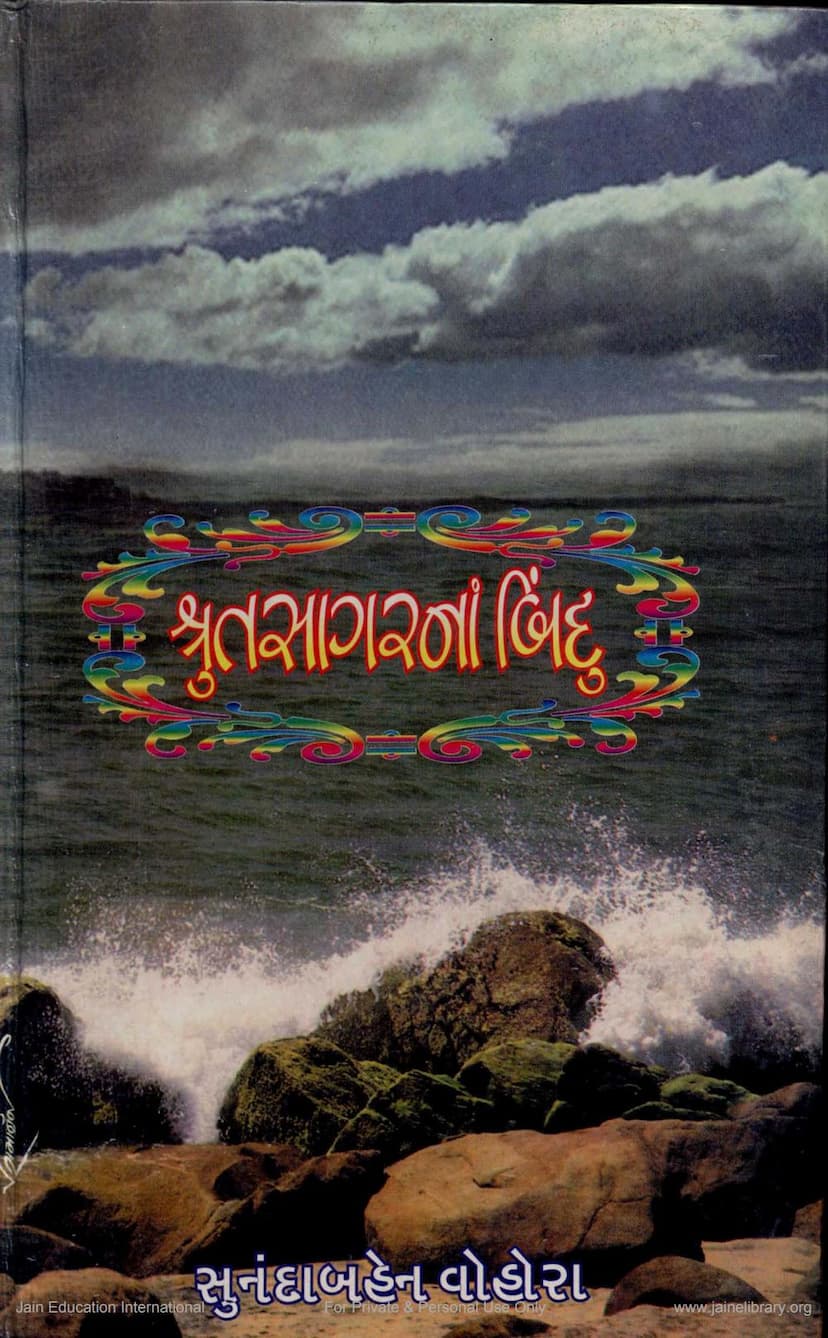Shrutasagarna Bindu
Added to library: September 2, 2025

Summary
Here is a comprehensive summary of the Jain text "Shrutasagarna Bindu" by Sunandaben Vohra, based on the provided pages:
Book Title: Shrutasagarna Bindu (Drops from the Ocean of Scriptural Knowledge) Author: Sunandaben Vohra Publisher: Gunanuragi Mitro, USA Publication Year: V.S. 2525 / 2055 (1998-99 CE)
Overview:
"Shrutasagarna Bindu" is a collection of spiritual insights and guidance presented in a concise and accessible manner, drawing from the vast ocean of Jain scriptural knowledge. The book aims to provide solace, wisdom, and a path towards self-realization for seekers. The author emphasizes that profound scriptures are born from the experiences, devotions, and compassion of great souls, acting as a source of divine wisdom for those who are spiritually inclined.
Key Themes and Content:
The book is structured into several chapters, each focusing on different aspects of Jain philosophy and spiritual practice. Here's a breakdown of the main themes covered in the provided pages:
-
The Nature of the Soul (Atman): The initial chapters delve into understanding the soul (Atman). It is described as the essence of consciousness, distinct from the physical body, which is merely a collection of material particles. The soul is eternal, unborn, and inherently pure, possessing infinite knowledge and bliss. The body, though the vehicle for experiencing happiness and sorrow, is temporary and composed of matter. The text stresses the importance of realizing the soul's true nature, which is often obscured by worldly attachments and ignorance.
-
The Path to Liberation (Moksha): The book outlines the path to liberation (Moksha) as a journey of self-realization. This involves understanding the soul's true form, detaching from worldly possessions and desires, and cultivating virtues like compassion, equanimity, and non-violence. The core principles of Jainism – Right Faith (Samyak Darshan), Right Knowledge (Samyak Gyan), and Right Conduct (Samyak Charitra) – are presented as the essential tools for this journey.
-
The Importance of Knowledge and Practice: The text highlights that mere intellectual knowledge of scriptures (Shruta Gyan) is insufficient. True spiritual progress comes from integrating this knowledge into daily life through practice (Achar) and experiencing its essence. The five types of scriptural study (Svadhyaya) are mentioned as a means to awaken self-awareness and connect with the soul.
-
The Nature of Karma: A significant portion of the book is dedicated to explaining the law of Karma. It emphasizes that every action (Karma) has a consequence, and the soul's present circumstances are a result of past deeds. The text clarifies that while external factors may serve as triggers, the soul itself, through its intentions and attachments (Ragadi Bhav), binds itself with karmic particles. Understanding the intricate workings of Karma is crucial for navigating the cycle of birth and death.
-
Ahimsa (Non-Violence): Ahimsa is presented as the supreme Dharma. It encompasses both external non-violence (Dravya Ahimsa) – refraining from harming any living being – and internal non-violence (Bhava Ahimsa) – abstaining from harmful thoughts, anger, and desires. The text stresses that true Ahimsa stems from recognizing the inherent oneness of all souls and cultivating love and compassion towards all beings.
-
The Role of Virtue: The book elaborates on the cultivation of virtues such as righteousness, truthfulness, non-stealing, celibacy, contentment, forgiveness, and charity. These virtues are not merely external practices but internal transformations that purify the soul and lead to spiritual growth. The author emphasizes that adherence to virtues, guided by the teachings of the Tirthankaras and enlightened gurus, is essential for progress.
-
The Power of Faith (Shraddha): True faith is presented as the bedrock of spiritual practice. Right faith in the Tirthankaras, scriptures, and gurus is essential for the correct understanding and application of knowledge. Faith provides the unwavering conviction needed to overcome challenges and persevere on the spiritual path.
-
The Nature of Happiness and Suffering: The text distinguishes between fleeting worldly pleasures and the eternal bliss of the soul. Worldly happiness, tied to external conditions and sensory experiences, is impermanent and often leads to dissatisfaction and suffering. True happiness, on the other hand, is found within the soul, in its inherent state of purity and peace, and is accessible through self-realization and detachment.
-
The Importance of the Guru: The guidance and grace of an enlightened Guru are deemed essential for navigating the complexities of spiritual practice and understanding the true essence of scriptures. The Guru acts as a guide, helping the seeker to overcome ignorance and realize their inherent divine nature.
-
The Significance of the Present Moment: The book encourages living in the present moment with mindfulness and awareness. Past regrets and future anxieties can hinder spiritual progress. By focusing on the present, one can cultivate inner peace and make steady progress towards self-mastery.
-
The Interconnectedness of Life: A key message is the interconnectedness of all living beings. Recognizing the soul's presence in every creature fosters compassion, empathy, and a sense of universal brotherhood, which are fundamental to the practice of Ahimsa.
Overall Message:
"Shrutasagarna Bindu" serves as a guide for spiritual aspirants, offering practical insights and philosophical depth from the Jain tradition. It encourages a life of virtue, self-discipline, and sincere devotion, ultimately leading to the realization of the soul's true, blissful nature and liberation from the cycle of birth and death. The book emphasizes the transformative power of understanding and practicing Jain principles, aiming to uplift the reader towards a life of meaning, peace, and spiritual fulfillment.